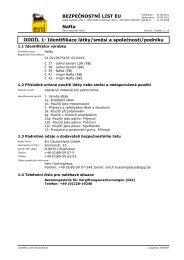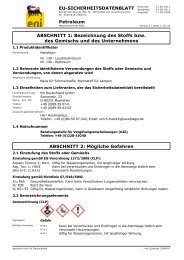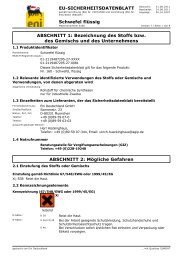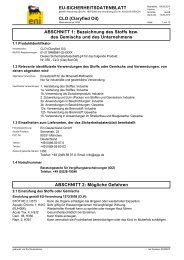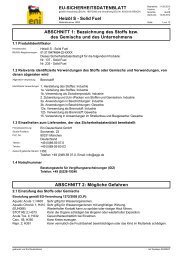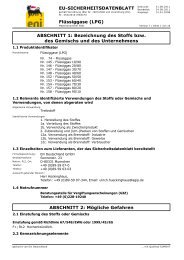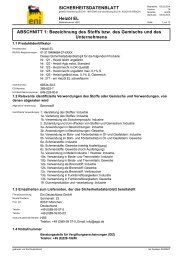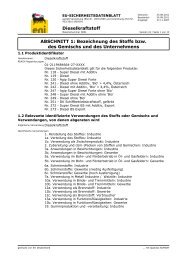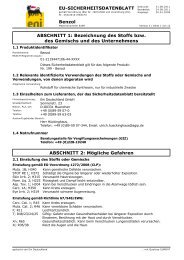EU-SICHERHEITSDATENBLATT Dieselkraftstoff ... - Schmierstoffe
EU-SICHERHEITSDATENBLATT Dieselkraftstoff ... - Schmierstoffe
EU-SICHERHEITSDATENBLATT Dieselkraftstoff ... - Schmierstoffe
You also want an ePaper? Increase the reach of your titles
YUMPU automatically turns print PDFs into web optimized ePapers that Google loves.
Vacuum Gas Oils, Hydrocracked Gas Oils, and Distillate Fuels<br />
APPENDIX 1: Category Justification Document<br />
Category Justification for Petroleum Substances<br />
Vacuum Gas Oils, Hydrocracked Gas Oils & Distillate<br />
Fuels<br />
Crude oil (Petroleum, CAS Registry Number (CAS RN) 8002-05-9) is a complex combination of<br />
hydrocarbons extracted in its natural state from the ground. It consists predominantly of aliphatic,<br />
alicyclic and aromatic hydrocarbons, but may also contain small amounts of nitrogen, oxygen and<br />
sulphur compounds. It is used as a feedstock for petroleum refining operations, which separates and<br />
converts it into fractions (streams). Petroleum refinery streams are used in a variety of applications,<br />
with the major proportion being used in the production of hydrocarbon transport fuels.<br />
Due to their method of production, and complex composition, it is not possible to characterise<br />
petroleum substances in terms of their exact chemical composition, molecular formula or structure.<br />
They are grouped together according to the process by which they are being manufactured and basic<br />
physical-chemical properties. Similar conversion and/or separation processes will result in streams of<br />
broadly similar composition. The resulting groups of petroleum substances have been used by the<br />
European Commission for the purposes of compiling Annex 1 to the Existing Substances Regulation<br />
(published in the Official Journal L84 on 5 April 1993), Annex XVII of REACH and Annex VI of CLP.<br />
The groups have also been used during discussions on <strong>EU</strong> harmonised classification and labelling<br />
and for some endpoints (particularly carcinogenicity) harmonised ‘group’ classifications have been<br />
applied to individual petroleum substances and are listed in both Annex 1 to 67/548/EC and Annex VI<br />
to CLP. In the USA, petroleum substances have also been grouped in categories for the purposes of<br />
the High Production Volume (HPV) Chemicals programme. The approach is broadly similar to that<br />
used in Europe, and has been accepted by the US EPA.<br />
This category justification has been prepared in accordance with the REACH Technical Guidance<br />
Document (May 2007) prepared under RIP 3.3.<br />
1. Category Definition<br />
1.1 Category Hypothesis and Applicability Domain<br />
This category, Vacuum Gas Oils, Hydrocracked Gas Oils & Distillate Fuels, covers a group (17) of<br />
petroleum gas oil substances used in the manufacture of distillate fuels (automotive diesel fuels,<br />
home heating oils, marine gas oils), petrochemical intermediates or gas oils used as components of<br />
formulated industrial lubricants and additives. They are not intentional mixtures of chemicals but are<br />
complex combinations of hydrocarbon species, produced to meet physical-chemical and technical<br />
performance specifications.<br />
The domain of this category is established by the refining processes by which the category members<br />
are produced and the boiling point and the carbon number range as follows:<br />
<br />
<br />
Derived from crude petroleum<br />
Refinery processes<br />
o Atmospheric distillation<br />
o Vacuum distillation<br />
o Hydrocracking<br />
o Blending of petroleum substances to produce the following CASRNs<br />
• 68334-30-5 Fuels, Diesel<br />
• 68476-30-2 Fuel Oil No. 2<br />
• 68476-31-3 Fuel Oil No 4<br />
• 68476-34-6 Fuels Diesel No 2<br />
2010-07-30 CSR Appendix 1




